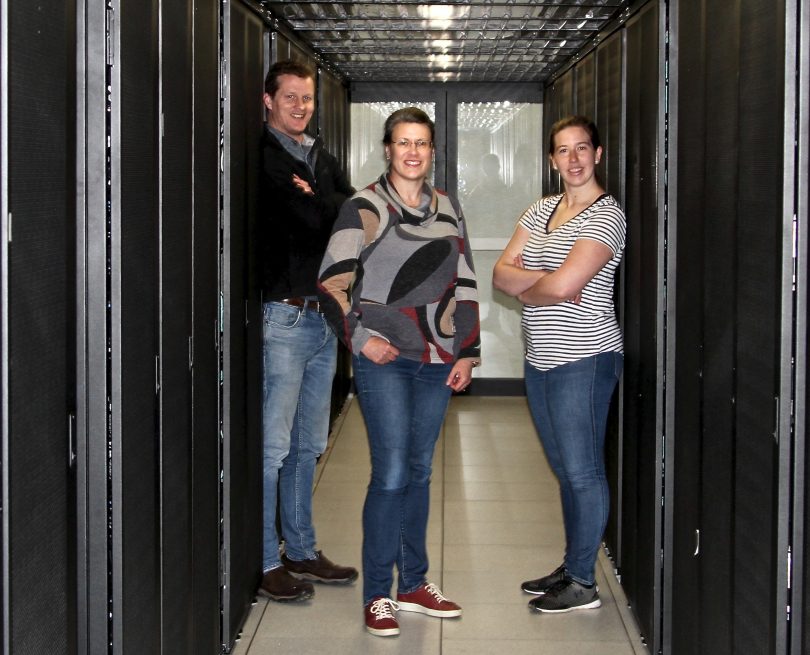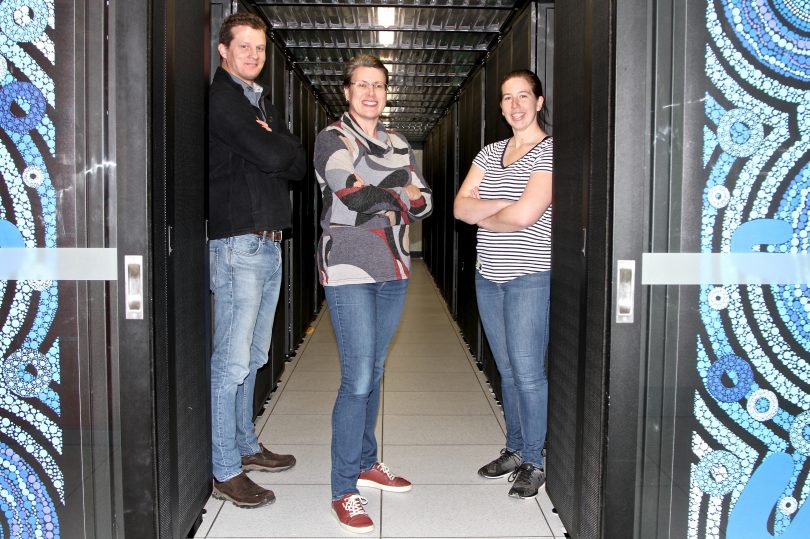
From left: Dr Stephen Fairweather, Associate Professor Megan O’Mara and Dr Katie Wilson with the Gadi supercomputer at ANU. Photo: Michael Weaver.
As the world waits for a COVID-19 vaccine, a supercomputer in Canberra is running simulations by the second that could unlock potential drug treatments.
The supercomputer, named Gadi, in the National Computational Infrastructure (NCI Australia) building on the Australian National University (ANU) campus will help a research team understand how COVID-19 invades human cells.
So powerful is Gadi it uses 48 processors running over 19 days to complete 64 simulations at a molecular level. In contrast, the same work would take a human more than 1500 years on one single computer doing constant calculations.
ANU researcher Associate Professor Megan O’Mara has at her fingertips the southern hemisphere’s most powerful and fastest supercomputer.
Associate Professor O’Mara and her team members, Dr Stephen Fairweather and Dr Katie Wilson, are running simulations on 800,000 atoms in a key receptor in the human body that COVID-19 is exploiting to attack our cells.
The receptor, known as ACE2, and another protein, called BOAT1, allow COVID-19 to infect a human cell.
Professor O’Mara will use findings from the simulations to understand the first step of infection by the virus. She says this vital work will help to understand how it invades our cells, and could lead to targeted drug design to stop it.
“It is only with high-resolution modelling that accurately replicates the true behaviours of these receptors that we can figure out where vulnerabilities in the virus’ binding process are,” said Associate Professor O’Mara.
“Targeting the interaction between the human receptors and the coronavirus binding protein might well be a useful direction for drug design. This project will produce world-first vital information about regions of the receptors that could be potential vaccine or drug targets.
“We will use the computer to screen drugs that bind to the receptor complex and can thus prevent the changes necessary for virus binding. Our goal is to identify drugs that can stop the virus from infecting human cells.”
The research, funded by NCI Australia, will spend around 13 million hours of computing time during the coming months.
NCI Australia also supports about 5000 researchers from government agencies including CSIRO, Bureau of Meteorology and Geoscience Australia, as well as academics from most universities in Australia.
“This allocation from NCI is absolutely essential for our research,” said Associate Professor O’Mara. “The receptor complex is so large and intricate that NCI’s new Gadi supercomputer is the only supercomputer in the southern hemisphere powerful enough to do these simulations.”
She is also working with medicinal chemist Associate Professor Mal McLeod and experimental biochemist Professor Stefan Broer, who are developing and testing the compounds that could lead to drugs that inhibit the receptor complex.
“Ideally, we want the vaccine, but you need different drugs for kids and elderly, and there are so many different conditions that mean different drugs are only effective for certain people,” said Associate Professor O’Mara. “So what we want to try to do is have a broad variety of drug options that can help people at different stages of the illness to stop them from developing full-blown COVID-19.
“As soon as we had a structure for the receptor of coronavirus, we started going with our research and started our simulations straight away. So basically at the end of February.”

From left: Dr Stephen Fairweather, Associate Professor Megan O’Mara and Dr Katie Wilson with the Gadi supercomputer and its Ngunnawal artwork. Photo: Michael Weaver.
Gadi [pronounced Gar-dee] is named in the local Ngunnawal language meaning “to search for” and is adorned with its own artwork, hand-painted by renowned Ngunnawal artist Lynnice Church.
The US White House Office of Science and Technology also named Gadi and CSIRO’s Pawsey Supercomputer Centre’s Nimbus as members of the US-led COVID-19 High-Performance Computing Consortium, which are being made available to researchers from around the world who are tacking COVID-19 from multiple angles.
The US consortium is a unique private-public effort spearheaded by the White House Office of Science and Technology Policy, the US Department of Energy and IBM to bring together federal government, industry and academic leaders who are volunteering free compute time and resources on their world-class machines.
Commissioned in late-2019, Gadi is also ranked as the 24th fastest supercomputer in the world and is funded by a $70 million investment from the Australian Government.
Original Article published by Michael Weaver on The RiotACT.






